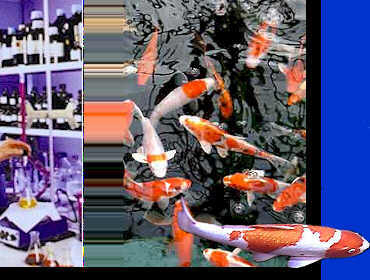|
|
Fin Disorders
|
Symptoms
|
|
Cause
|
|
Treatment and Links
|
| A). The fish spread their fins, dart about and
breathe rapidly |
 |
The pH may be too low |
 |
Do a pH test and use baking soda to raise it up
to the required level. |
 |
|
 |
|
|
| |
|
Could be poisoning, or high ammonia levels |
 |
Change the water several times and filter over
fresh, activated charcoal. |
|
| B). The fins fray and the skin fades
until it is whitish |
 |
The pH can be too high |
 |
Do several water changes. If this does not
help, lower the pH with Sodium Bisulfate -or- Sodium Monophosphate |
 |
|
| C). Black or brown nodules appear on
and between the fin rays and at their bases |
 |
If the fish were captured in the wild, they
could have encapsulated worm larvae (metacercariae) |
 |
Treat with:
De-Los |
 |
|
| D). Red worms appear at the bases of
the fins |
 |
Bloodworms (Philometra sanguinea) in the blood
are involved |
 |
No treatment known, in the aquarium there is no
danger of any spread of the parasite. |
 |
|
| E). The fish compress their fins and
scrape themselves. Worms are apparent |
 |
The fish are affected by a skin infection |
 |
Treat with: Praziquantel -or-
De-Los -or-
Parinox |
 |
|
| F). White dots, up to 1mm in size,
form on the fin edges and surfaces |
 |
a). Your fish is affected with Ichthyophthirius
(Ich).
b). In saltwater, Cryptocaryon Irritans |
 |
a). Use:
Forma-Green
-or- Quinine Sulfate b).
Use: Quinine Sulfate -or- Forma-Green
-or- Copper Sulfate. |
 |
|
| G). A velvety coating forms on the
fin edges and the sides. With a magnifying glass, the
individual dots are visible |
 |
Your fish are affected by Oodinium |
 |
Use:
Forma-Green -or-
Copper Sulfate. |
 |
|
| H). The fins, edged in white, grow
shorter and shorter |
 |
Bacterial fin rot, or too high pH |
 |
Check the pH. If this is not the
case, treat with:
TMP Sulfa -or-
Sulfa 4 TMP |
 |
|
| I). Small, white, cauliflower
looking substances are attached to the fins, or at the base of
the fins. |
 |
Your fish is affected by the Lymphosistis virus |
 |
No suitable treatment known. |
 |
|
| J). Wormlike cysts, measuring up to
1cm are found in the fins |
 |
Probably Dermocystidium |
 |
No suitable treatment known. |
|
 |
|
|
|
|
| K). The fish have redness at the base of
the fins, or... red streaking in the fins and/or body. |
 |
Your fish are affected by Hemorrhagic Septicemia |
 |
Treat the fish with
Doxycycline -or- Oxytetracycline for 10 days. |
| |
|
Home
ı
Articles ı
Prevention ı
Fish
Diseases ı
About Us ı
Contact Us ı
Terms of Use ı
Privacy Policy ı
Shipping ı
Products |

